Drilling a New Well
We are drilling a new well!
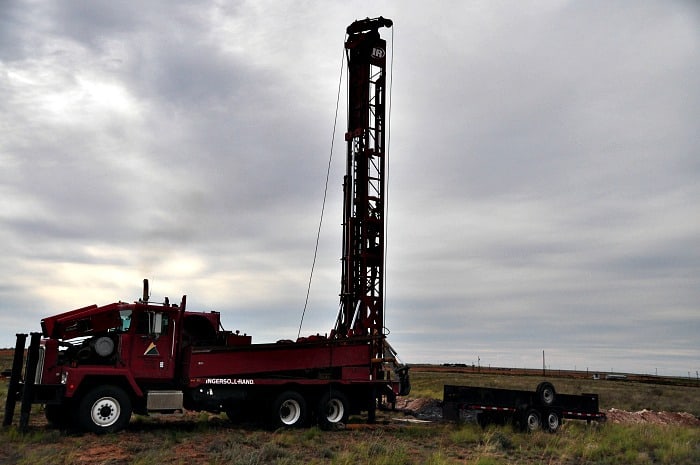
The time has come to drill a new well. In the almost 6 years that we have lived here in west Texas, our water levels in each of the wells have dropped. Unfortunately, it is not just us, it is everyone in this area. When we bought the land in 2007, there were already 3 wells on the property. At that time, after test pumping to see how much water they could produce, we put submersible pumps down 2 of them.
In 2008, we began the vineyard and could continuously irrigate 10 acres at a time. Pumping more than 120 gal. per min. Now, the wells refill rate allows us to irrigate only five acres semi-continuously, pumping ~50 gal. per min.
Don’t get me wrong – We still have more than enough water for our home, animals and the existing vineyard. But, we want to continue to expand, planting more acres of grapes for all the children. Since the current wells’ capacities have dropped so much, we need to make sure there will be enough water to match our plans.
The Original Wells
The three original wells reach down ~130 ft to the Ogalala (try saying that 5 times fast!) aquifer. Locally called “the blue clay”. The new well will reach down ~420 ft to the Trinity-Edwards aquifer, also called the “red clay”.
Where to Drill – The Start of Drilling a New Well
We wanted to have the new well close to the new barn so as to piggyback the electricity lines. So, the drilling rig set up to the southwest of the barn. We were repeatedly asked about how we decided where to drill and if we were going to have someone witch it for us. But as we responded to all the questions, we prayed that God would put on our hearts where He wanted us to find the water we needed. We were hoping that God didn’t have a very expensive lesson for us to learn.
The Drilling Rig
At the back of the drilling rig, you can see the heavy pipe (drill stem) used to bore the test hole. As the drill stem turns into the ground, water is pumped down through its center to the bottom of the hole. The dirt, sand, rock and clay are chewed into by the drilling bit and washed up and out the top of the hole by the water flow. The mud slurry flows into a settling hole where most of the solids fall out of suspension. The water is then recycled (via the hose) and pumped back down the drill stem.
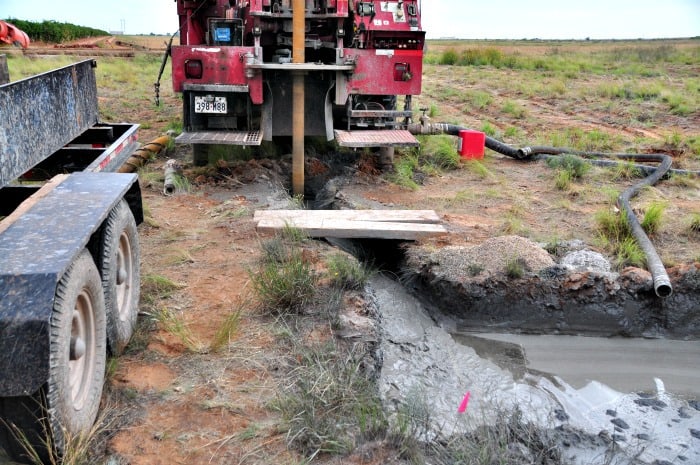
Here is a close-up shot of the actual spinning drill stem. You can see how thick the mud slurry is coming out of the hole!
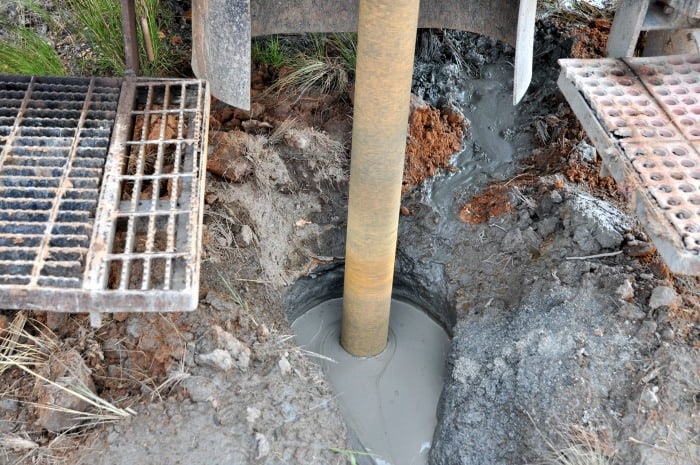
Three Days
After three days of drilling a six inch pilot hole, the driller hit the red clay. That indicated he had gone deep enough. He then wallowed out the hole to twelve inches over the next few days. Then, they moved out the drilling rig and brought in a crane to insert the ten inch steel well casing. The casing was lowered into the hole in 20 ft sections which were welded all together as they were lowered. Below is the crane starting to lift up one of the huge sections.
The Crane at Work
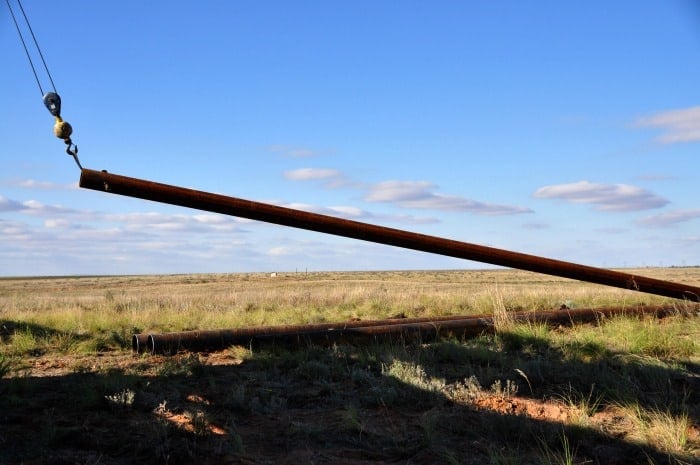
Welding the Casing
And here they are welding the sections together before lowering the whole casing further in.

The Fast Bailer
The casing was finished last Thursday but we had to wait until Monday for the the next step – the fast bailer. A fast bailer is essentially a long piece of pipe with a flapper on the bottom. This is dropped to bottom of the well where the loose sand and mud flow up into the pipe. As the pipe (bail) is raised, the flapper closes and the muddy/sandy water can be hoisted out. The goal is to remove as much sand as possible (as the well replenishes) in preparation for test pumping with an electric submersible pump.
In the photo below, the man is standing behind the shoot of the fast bailer. The bail is the pipe section just above his head. The flapper has just been released and the muddy water from the bottom of the well is dumping into the former settling hole. Sprinkles (in the bottom right) is wondering if she can go swimming yet!
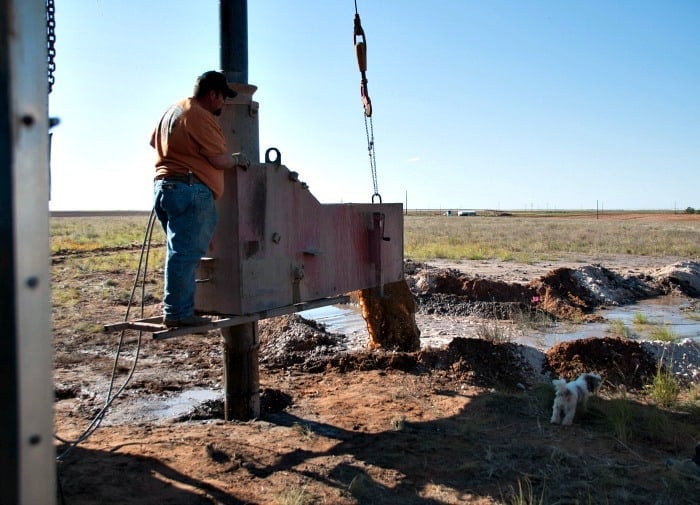
Test Pumping
After the fast bailer came test pumping to see just how much water our new well was capable of producing. The fast bailer did a good job of cleaning out the sand. As you can see below the water is quite clean.
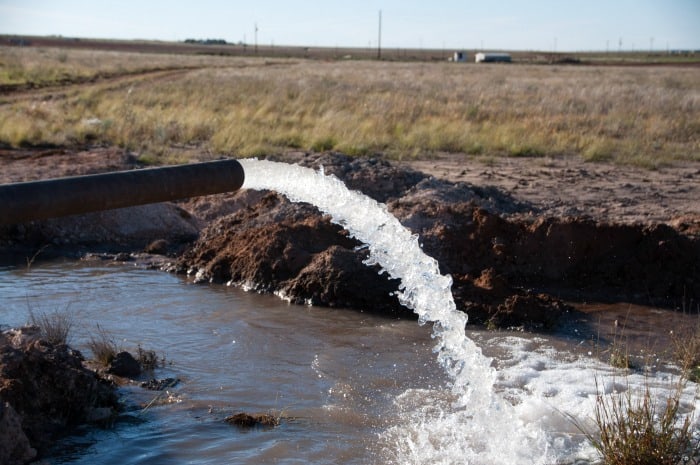
The test pumping will continue for three or four days. But it seems that we’ll have enough water to sustain the expansion of the vineyard for the children!
For more vineyard posts, check out the links below!

Congratulations!!!! Water is the lifeblood of a High Plains vineyard, I look forward to hearing the flow rate.
I appreciate you sharing your experience getting a new water well drilled so that we can better understand the process that is undertaken. It helps to know what to expect with a well drilling so that we can prepare for the process. It’s amazing how quickly a job like this can be done if you think about how long it would take to drill so deep without the right kind of equipment.
Thanks for taking the time to comment, Bernard! You are right, I can not imagine drilling without that machinery!
I never took into account that the drilling can even last for about three days until the clay has been hit. I just got curious about how this works because we will be having one drilled in the farm that we just bought. It will be the main source of drinking water for the cattle to save money from water bills.
Millie, I know it is amazing. Good luck with your week and farm!